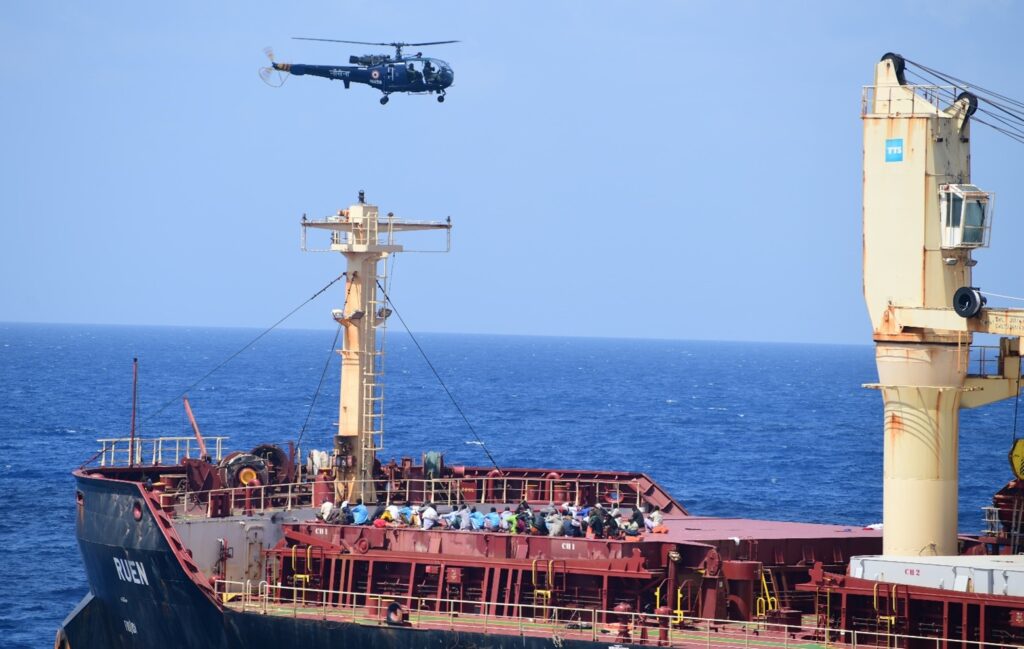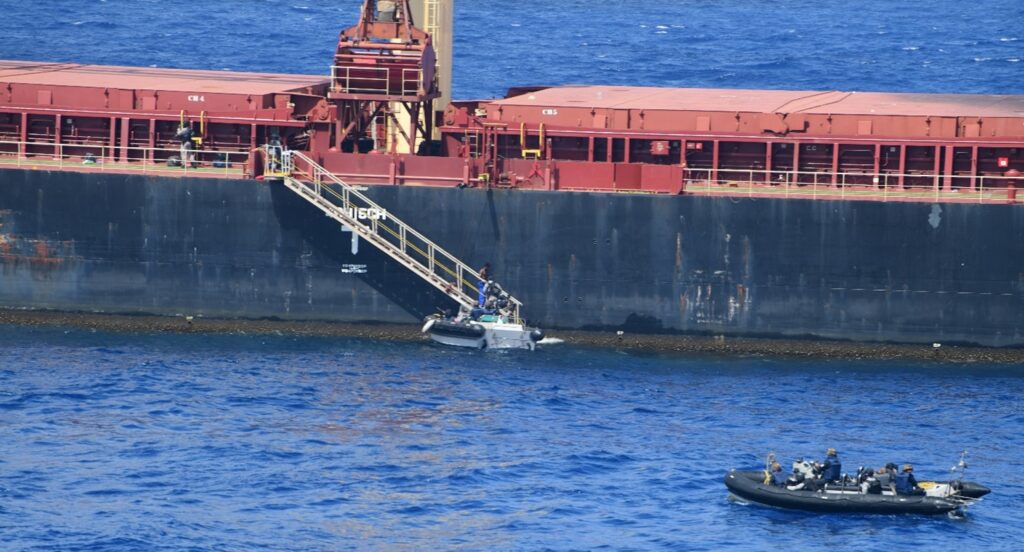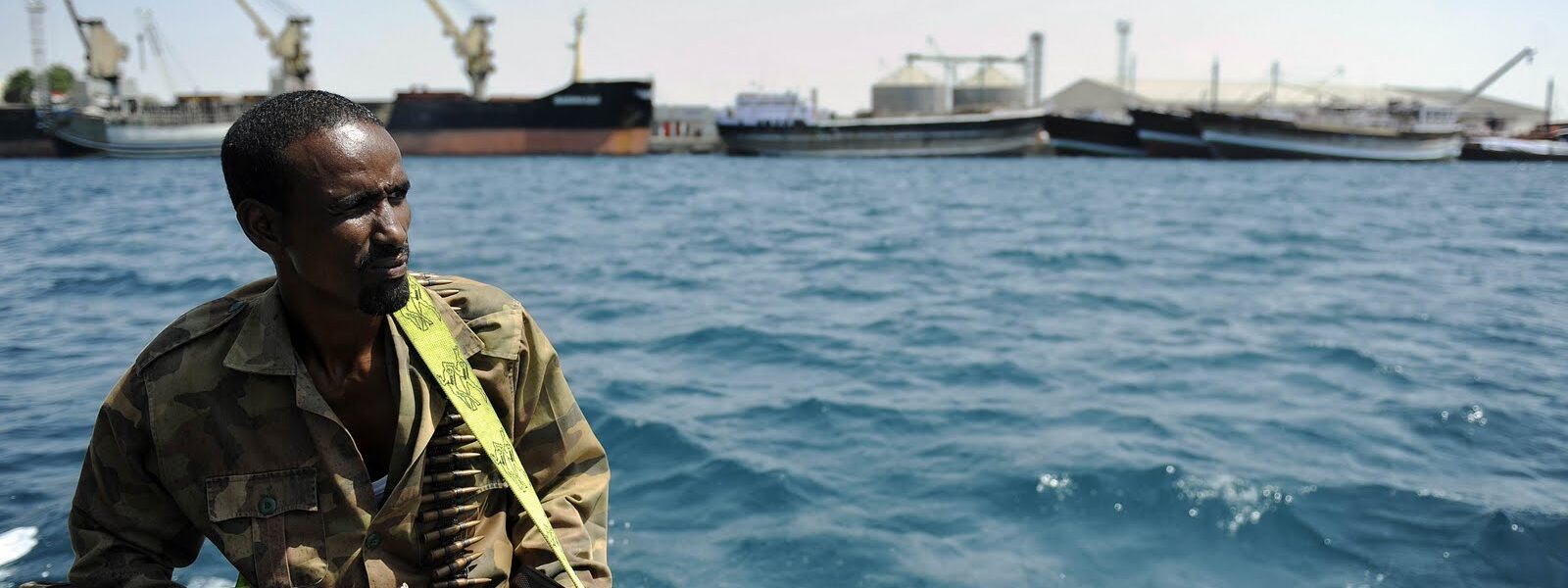NSN Exclusive: Perfect storm created for Somali pirates to return but strong resurgence unlikely – Denys Reva ISS
Somalian pirates are exploiting the crisis in the Red Sea, seeing it as an opportunity to target ships off Somalia’s coast.
The World Bank has estimated that pirates operating off the Horn of Africa amassed between $18 billion annually during the period from 2005 to 2012 by holding crews and cargo for ransom. The gravity of the situation prompted a multilateral response from the five members of the UN Security Council, while ship owners and flag states implemented special anti-piracy measures for self-protection.

Denys Reva, a maritime expert at the Institute of Strategic Studies, told National Security News in an interview that these measures created conditions that significantly hindered pirate activities in the region, leading them to switch to other criminal activities, such as smuggling, and trafficking of people and arms. However, Somali pirates are staging a comeback with twenty reported piracy cases since November 2023, capitalising on what Reva describes as a perfect storm for their re-emergence.
He said ships have stopped adhering to safety procedures, and the attention of regional naval forces has been diverted to the Houthi attacks in the Red Sea. The Indian Ocean Commission (IOC), a regional body comprising countries in East African waters, including Seychelles and the Comoros, has described the latest incidence of piracy as “worrying”. Reva informed NSN that the occurrence of at least two successful hijackings by Somalian pirates is a cause for concern and warrants attention. Despite previous attacks, he does not anticipate a return to previous levels of piracy in the Horn of Africa. He highlighted the response from the Indian Navy, which rescued the commercial ship MV Ruen from pirates off Somalia’s coast, as a potent deterrent.
20 cases of piracy involving Somalian pirates since November last year
From November last year, there were approximately 20 reports of suspected piracy incidents. It’s crucial to approach these suspected incidents with caution. A ‘suspected incident’ is essentially a report from the ship’s captain indicating that something has occurred. Sometimes, it’s a legitimate risk, while other times, it’s more of a precaution. There have been instances in the past where the mere activity of a fishing vessel in the vicinity was perceived as suspicious. However, we have witnessed at least two successful hijackings, which is a cause for concern and something we should be looking at. This is an indicator that demands our attention.

The origins of piracy in Somali
The history of Somali piracy is quite intriguing, as it’s often misunderstood. Essentially, Somalia, as a state, has experienced turbulent times, particularly in the early 2000s. This led to Somalia being labelled as a failed state, a term some may recall. In practical terms, this meant that the Somali government didn’t have full control over its territories and couldn’t enforce laws there. As a result, existing criminal networks in the region saw an opportunity and decided to exploit this situation, leading to piracy and other instances of maritime crime.
The origins of piracy are also interesting and vary depending on who you ask. For instance, the pirates themselves claim that what eventually became piracy started as a maritime militia. Somalis were protecting their territorial waters and traditional fishing grounds from the incursions of illegal fishing vessels from non-African states. This was indeed the case when the Somali government lost effective control over its territories and waters. Other state and non-state actors from around the world exploited this vacuum.
One origin story for the emergence of piracy is that the Somali people came together to fight back against these incursions, which eventually transformed into piracy. However, it’s more likely a combination of several factors. The criminal networks saw an opportunity as well.
Piracy relies on the distinction between territorial and international waters
The phenomenon of piracy largely hinges on the distinction between territorial and international waters. Territorial waters, controlled by the state, extend 12 nautical miles from the shore. The challenge with piracy is that if a ship is hijacked and brought into a state’s territorial waters, it is the state that has the logistical power to respond. International naval forces, generally speaking, would not be able to intervene.
This is one of the challenges when addressing piracy and one of the reasons why piracy in Somalia escalated to such an extent. A combination of factors, including the troubles in Somalia, lack of oversight, and inability to control the maritime domain, along with the increasing shipping off the coast of Somalia, created perfect conditions for criminal networks to exploit. These factors collectively contributed to the rise of piracy.
Somali piracy was constrained, but a long-term solution was not provided
Piracy was indeed contained, but it didn’t completely disappear. As I mentioned earlier, piracy was conducted by criminal networks, much like any other criminal activity. It’s a matter of cost-benefit analysis. At some point, it became too risky for pirates to operate in the region.
The business model for pirates is quite simple. They capture an insured boat, bring it into Somali waters, and negotiate a ransom. This profit is then split among the group, with most of it going to the pirate boss. The pirates themselves usually don’t see much of the money from their actions.
However, Somalia is a very poor state, and at some point, a combination of international efforts, including naval responses and other initiatives from the UN to regional efforts, created conditions that made it very risky for pirates to operate in the region. As a result, these groups switched to other criminal activities, such as smuggling and trafficking people and arms.
As criminals, they are constantly on the lookout for economic opportunities. One such opportunity presented itself with the ongoing crisis in the Red Sea and the conflict with the Houthis. It’s fair to say that while pirates have been constrained, they haven’t disappeared and continue to look for opportunities to return to their activities.
A perfect storm has being created for Somalian pirates to return
Just as with the previous resurgence of piracy, a combination of factors created the perfect conditions for its return. The Houthi rebellion, for instance, diverted a lot of attention away from the naval forces present in the region. It’s also important to remember that there were no recorded successful hijackings since around 2017 due to effective measures put in place. However, these measures have been criticized for being effective in combating pirates but not providing a long-term solution to the problem of piracy or addressing the conditions that led to its emergence in Somalia.
Since there were no successful attacks recorded since 2017, the attention and resources dedicated to this issue were reduced. The UN Security Council resolution that provided legitimacy and authority to the international community to act in Somalia’s territorial waters, approved by the Somali government, was not prolonged. In 2022, the high-risk area, denoting the area of the sea where ships had to implement specific security measures, was removed in January of 2023.
This reduction in effort and attention, coupled with the ongoing conflict in the Red Sea and attacks on ships by the Houthi rebels, created an opportunity for pirates to strike. The measures that were implemented were effective in deterring pirates and made it very difficult for them to board ships. However, these measures came at a high cost for shipping companies. Once the high-risk area was removed, there was no incentive for shipping companies to continue spending additional money and resources, creating additional incentives for pirates.
Most instances of piracy attacks since 2013 were mostly connected to cases where ships did not follow safety procedures. Now that ships are no longer following these procedures and are not forced to by insurance companies, it creates additional opportunities for pirates. The diverted attention from the naval forces in the region creates a perfect storm, so to speak, for the pirates to re-emerge.
Shipping is being rerouted via Africa, but less than expected
The shipping industry is facing a double challenge with the Houthi attacks and the resurgence of Somali pirates. As a result, some shipping firms have started avoiding the Red Sea due to these risks and are increasingly choosing the longer route via Africa, specifically South Africa, as their shipping route.
Shipping companies have been avoiding the Red Sea due to risk and has been choosing the longer route via Africa but not to the extent initially suspected. The Cape route is the alternative for shipping companies, but it is a more expensive route due to the longer distance that needs to be travelled. We have seen some traffic being diverted to go through the Cape route, the traditional historic route before the Suez Canal was opened.
The shipping industry in the region is definitely feeling the impact, although it’s not as severe as it was during the height of the piracy attacks. It’s also worth mentioning that the high-risk area in the region related to piracy incidents was removed, which reduced the cost for the shipping industry.
As long as the ongoing hostilities can be contained by the international community, it’s likely that there won’t be long-term consequences for the shipping industry. However, if the conflict continues, we may see higher impacts.
What shipping companies can do to combat Somali piracy
The good news is that despite the erosion of some systems that originally contained piracy, is that some of these systems are still operational. One such system is the Best Management Practices (BMP5), a document developed by the shipping industry to advise shipping companies on safety measures in high-risk areas, such as off the coast of Somalia. Despite its mundane name, BMP5 is a crucial document for the industry, outlining all the safety measures a ship’s captain must follow. These measures, which include staff training, briefings, safety precautions regarding the ship’s speed, equipment carried, and possibly the presence of security guards, remain effective.
However, the challenge lies in the lack of incentives for ships to adhere to these safety measures. Despite this, the measures are in place, and a framework of operations has been established that we know works.
Communication centres, such as the UK Maritime Trade Operations (UKMTO) with headquarters in Dubai, exist in the region. These centres play a vital role as, before traversing these waters, the shipping company contacts the centre, allowing the centre to track the ship’s movement through the region. If any issues arise, they are communicated to the centre, which then relays this information to the local naval forces. This simple precaution, while not mandated by anyone, is a service provided by the government and shipping industry in the region that aids the shipping industry.
Continuing with the best management practices is crucial. I want to reiterate that in the past, most of the ships that were successfully hijacked were not following the best management practices. Simply adhering to these practices, which unfortunately come at a slightly higher cost, can prevent hijackings, which are undoubtedly more costly
A strong resurgence of Somalian pirates is unlikely
Despite recent attacks, I don’t believe we will see a resurgence of piracy as serious as happened before. I might be speculating or perhaps very hopeful. The response from the Indian Navy, in particular, sent a strong message. The way the MV Ruen was rescued, it sent a strong message. From the point of hijacking, the Indian Navy and the European Navy in the region tracked the ship all the way to the coast. They collaborated and used unmanned aerial vehicles to control the movement of the ship, which led to the successful rescue of the vessel and its crew.
The strong response from the international community sends a very strong and clear message to pirates, increasing the risk associated with their operations. However, much will depend on the negotiations for the recently hijacked Bangladeshi flagged vessel currently located in Somalia. This was the second hijacking. The ransom negotiation process will determine how pirates and existing criminal networks perceive the risk-reward balance of these activities.




















































































































































































































